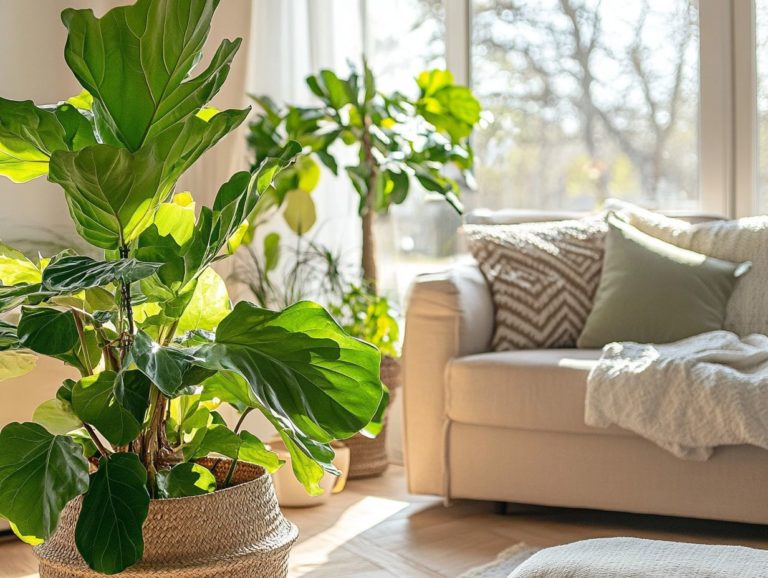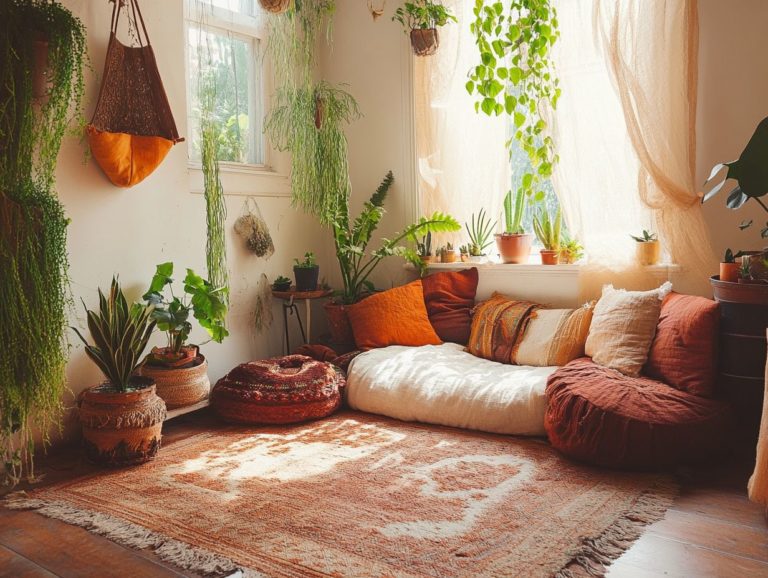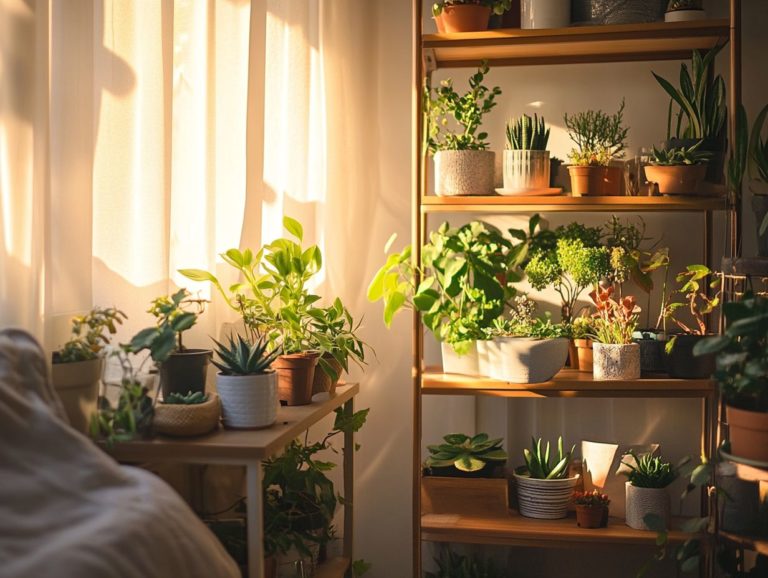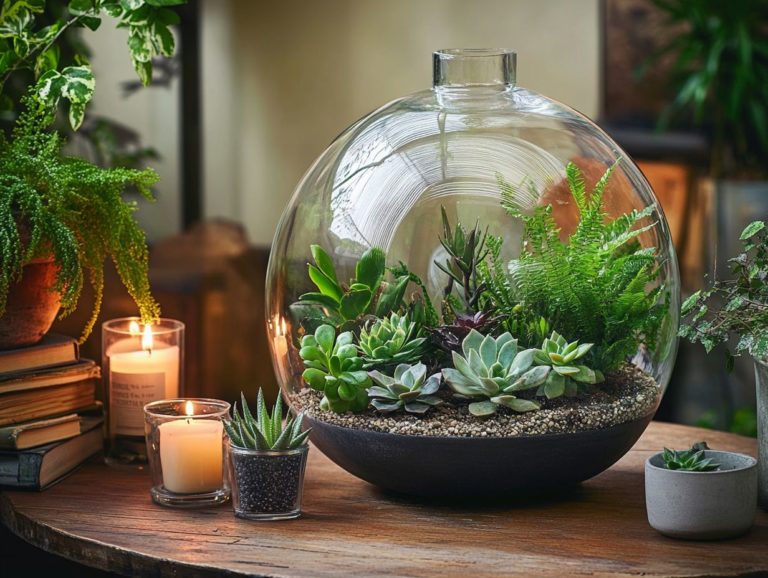The Art of Layering Plants in Your Decor
Transforming your space with plants goes beyond simply placing a few pots here and there; it s an art form known as plant layering. This beautiful way to arrange your plants not only elevates the look of your home but also helps keep the air healthy.
You will also find valuable tips for keeping your plants healthy.
Jump in and transform your space with vibrant layers of nature!
Contents
- Key Takeaways:
- Benefits of Incorporating Plants in Decor
- Key Factors for Layering Plants Successfully
- Types of Plants for Layering
- Tips for Layering Plants in Your Decor
- Maintenance and Care for Layered Plants
- Frequently Asked Questions
- What is the art of layering plants in your decor?
- Why should I incorporate layered plants in my decor?
- What types of plants work best for layering?
- How do I arrange layered plants in my decor?
- Do I need to have a green thumb to successfully layer plants in my decor?
- Are there any tips for maintaining layered plants in my decor?
Key Takeaways:
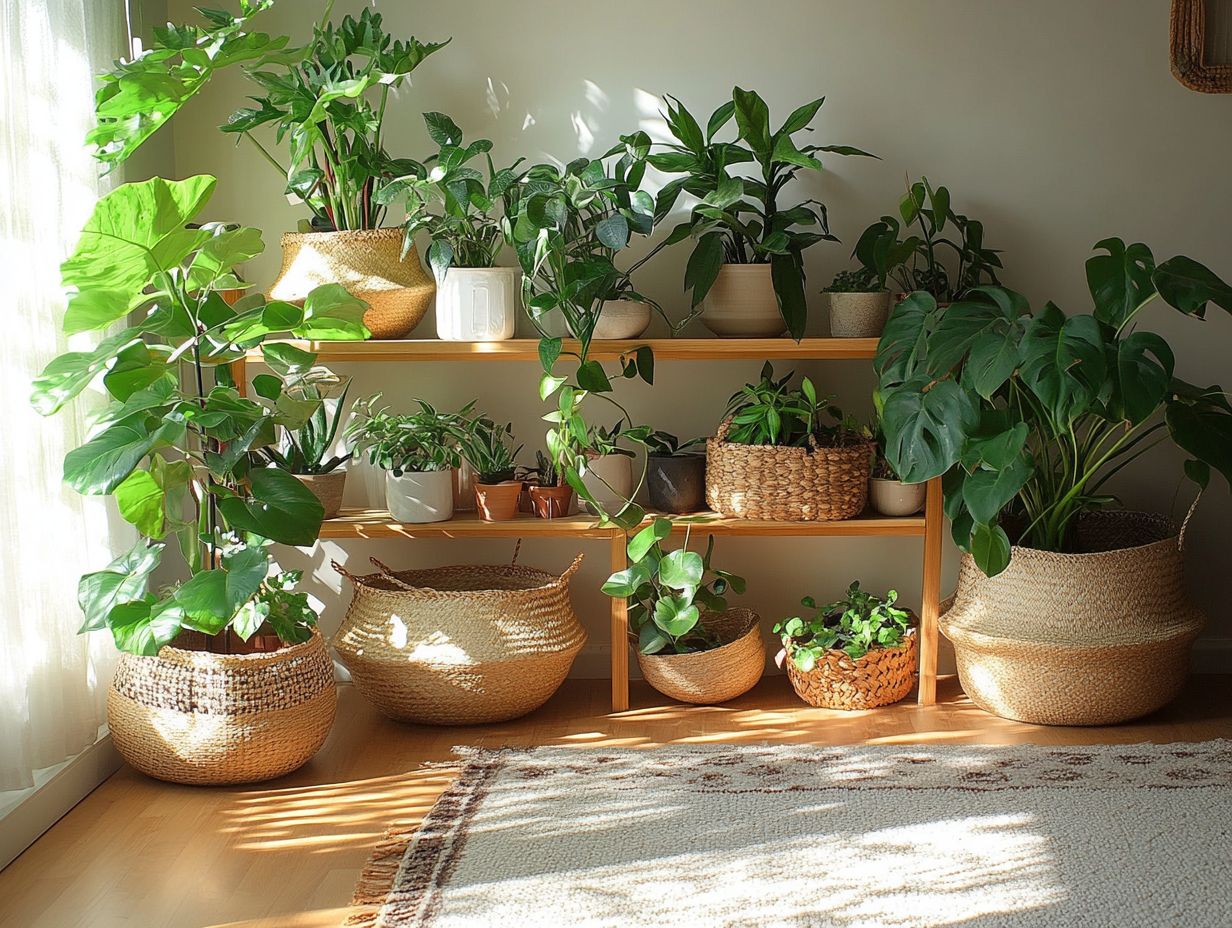
- Incorporating plants in your decor adds beauty and improves the air quality in your home.
- When layering plants, consider their light, water, and space needs to ensure health and growth.
- Creating balance and interest through proper placement is key to successfully layering plants.
What is Plant Layering?
Plant layering is a technique in indoor gardening that allows you to arrange plants of different heights, textures, and colors, creating a visually stunning environment. This method not only enhances the look of your indoor space but also helps each plant thrive by mimicking the balance found in natural ecosystems.
By thoughtfully selecting houseplants such as succulents, pothos, and peace lilies, you can create a layered garden that brings vibrant greenery and captivating visuals into your decor.
To enhance this layering technique, consider using decorative pots with diverse designs. Choose larger pots for your taller plants and smaller pots to beautifully complement mid-tier and lower-height varieties. Additionally, using indoor plants for seasonal decor can elevate your arrangement, maximizing your space and fostering unique micro-climates, which are small areas with different temperature and humidity levels that encourage growth.
Understanding the principles of micro-climate gardening helps you see how factors like humidity and light benefit specific plant species. This interconnected approach brings the beauty of nature closer to your home, creating a serene atmosphere that promotes well-being and tranquility.
Benefits of Incorporating Plants in Decor
Incorporating plants into your home decor provides many benefits that go beyond aesthetics. It transforms your indoor spaces into vibrant living environments, actively reducing stress levels and promoting overall wellness.
The presence of greenery enhances mental clarity, improves air quality, and creates a soothing atmosphere, turning your home into a true oasis of calm.
By choosing the right plants and houseplant accessories, you can create a space that delights the eye and enriches your mental and emotional well-being.
Improved Air Quality and Aesthetic Appeal
Improved air quality and aesthetic appeal are two excellent reasons to incorporate plants into your indoor environment. Houseplants like snake plants and orchids not only purify the air by absorbing toxins but also infuse your living spaces with vibrant greenery and color.
These plants excel at filtering harmful substances such as formaldehyde and benzene, cultivating a healthier atmosphere for you and your guests. By choosing varieties like pothos and peace lilies renowned for their low maintenance and stunning foliage you can effortlessly create an inviting atmosphere.
Arranging these greens in appealing clusters or alongside colorful pots can create a polished aesthetic that draws the eye. Thoughtful selection ensures each plant enhances your decor while enriching your indoor ecosystem, beautifully merging style with sustainability.
Key Factors for Layering Plants Successfully
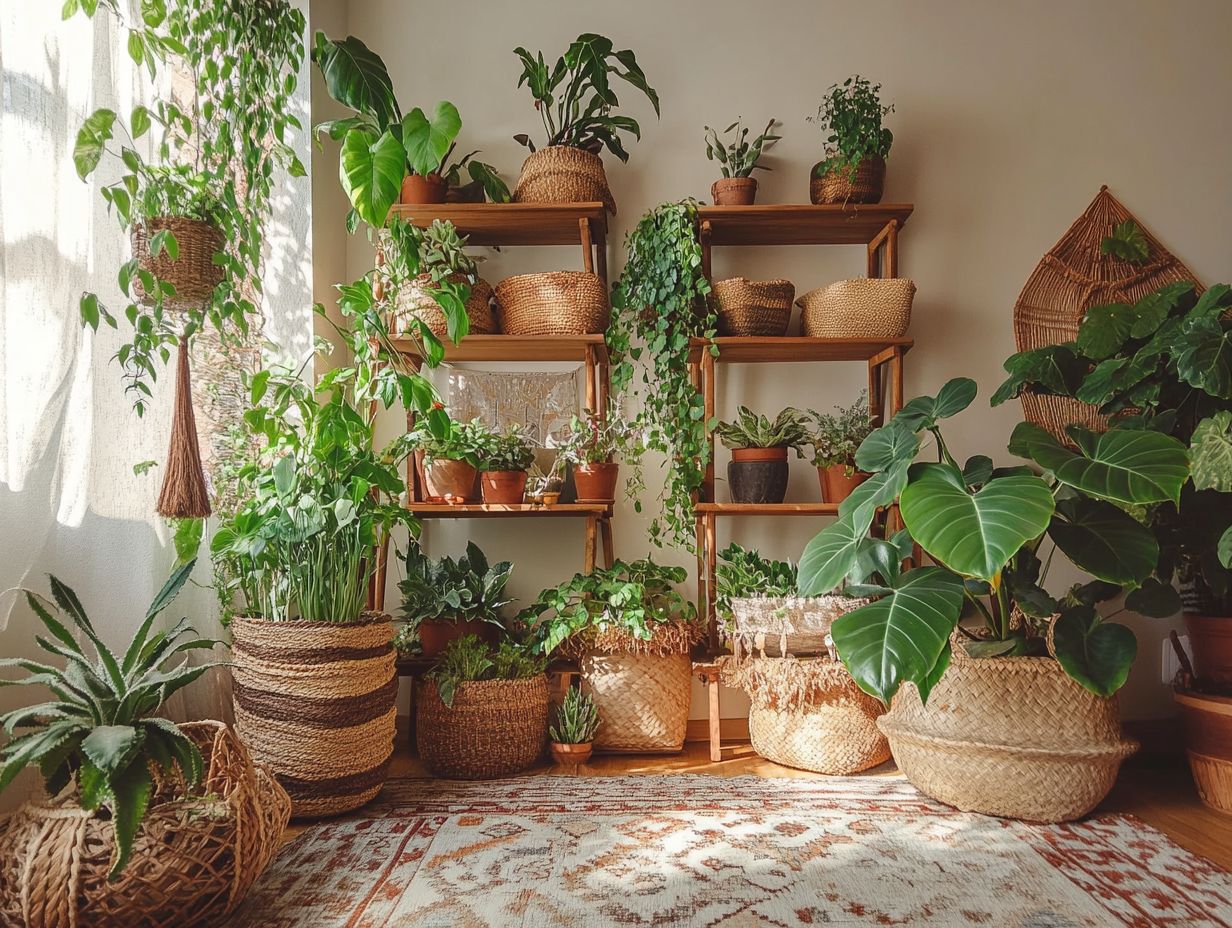
Ready to layer plants in your indoor garden? Let’s explore some important things to think about to ensure your plants thrive and enhance your overall design.
Start with light requirements: different plants have distinct needs for sunlight, so it’s essential to match their preferences.
Next, pay attention to their water needs, which can vary significantly depending on your selection.
Manage space wisely to prevent overcrowding in your arrangement.
By following these indoor gardening tips, you can craft a stunning and functional layered garden that promotes the health and vitality of your plants.
Light, Water, and Space Requirements
Understanding the light, water, and space requirements of your plants is crucial for effective maintenance, especially when layering them in your indoor decor.
Different house plant varieties, like bonsai (small, ornamental trees) or peace lilies (low-light loving plants with beautiful white flowers), have unique light needs ranging from full sunlight to low-light conditions.
They also have varying water requirements. Some may flourish with minimal watering, while others demand more frequent attention.
Manage space thoughtfully to ensure each plant can spread its foliage, enhancing both its health and the overall design of your indoor garden.
Take succulents, for example. They re perfect for beginners due to their low water needs and their ability to thrive in bright, indirect light.
On the flip side, ferns prefer moist soil and indirect light, introducing a lush, vibrant element to your space.
When planning a balanced garden, group plants with similar environmental needs together. This approach fosters optimal growth and creates an aesthetically pleasing arrangement.
This setup boosts your greenery s vibrancy and simplifies your care routine!
Types of Plants for Layering
When choosing plants for layering in your indoor garden, a rich array of options can elevate both the aesthetic and functional aspects of your space.
Seasonal plants, low-maintenance varieties, and beloved houseplants like snake plants, pothos, and orchids each play distinct roles in your layered design.
By thoughtfully selecting your indoor plants, you can craft unique arrangements that not only enhance the beauty of your environment but also foster a thriving ecosystem.
Choosing the Right Plants for Your Space
Choosing the right plants for your indoor space is essential for achieving a cohesive look and elevating your overall decor.
Consider factors such as light availability, humidity, and space constraints to guide your plant selection. This ensures that each plant can truly thrive in its designated area.
Opt for stylish containers and decorative pots to elevate the beauty of your arrangements, adding visual intrigue to your indoor gardening endeavors.
It’s crucial to consider the unique characteristics of each room. For example, a well-lit living room is ideal for sun-loving varieties like succulents or snake plants, while a kitchen with sufficient humidity creates a perfect haven for herbs like basil or mint.
In bedrooms, air-purifying plants such as peace lilies or spider plants can enhance air quality while fostering a calming atmosphere.
Don’t underestimate the power of containers. Vibrant or uniquely shaped pots can transform even the simplest plant into a striking focal point, ultimately enhancing the ambiance of your home.
Tips for Layering Plants in Your Decor
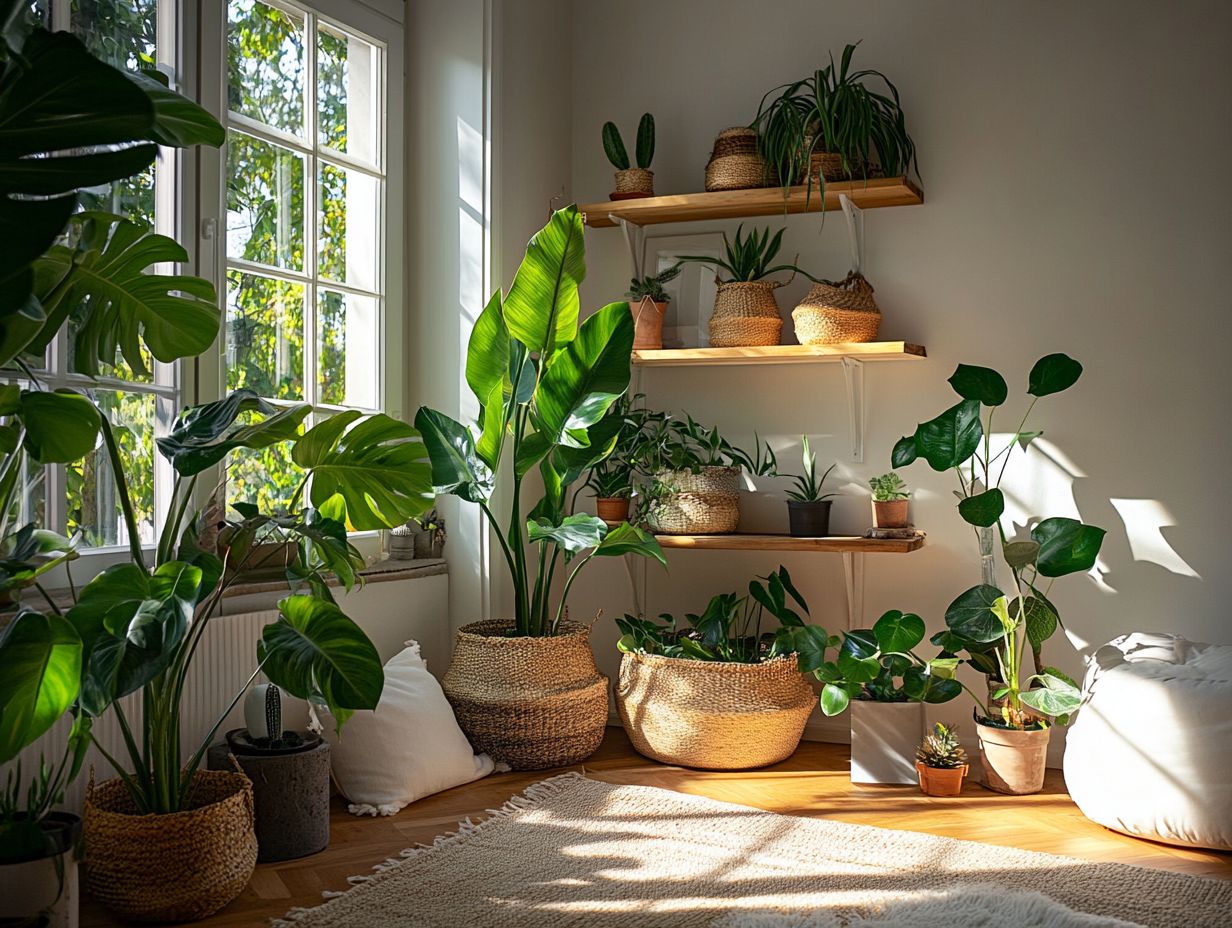
Effective layering of plants in your decor demands thoughtful planning and a keen understanding of design principles to establish balance and visual intrigue.
By thoughtfully grouping plants of varying heights, colors, and textures, you can cultivate a layered garden that captivates the eye and elevates the overall aesthetic of your indoor spaces.
Embracing indoor gardening tips will enable you to optimize your arrangements, ensuring that each plant not only complements its neighbors but also flourishes in its environment.
What plants are you excited to layer in your home? Discover the benefits of using indoor plants in your decor and start creating your indoor oasis today!
Creating Balance and Visual Interest
Creating balance and visual interest in your plant arrangements is essential for achieving a harmonious indoor decor. By thoughtfully considering how to group your plants based on height, foliage colors, and textures, you can craft an eye-catching display that captivates and soothes anyone who lays eyes on it. Choosing decorative pots that complement your selected plants enhances the overall aesthetic, adding appeal and cohesion to your indoor gardening project.
To successfully blend various plant types, think about incorporating a mix of trailing, upright, and bushy varieties, allowing their unique shapes to contrast beautifully. Layering your plants by placing taller specimens at the back and shorter ones in the front creates a pleasing depth, engaging the eye as it travels through the arrangement.
Selecting a color palette that ties together your plants and pots ensures a unified look; for instance, soft pastels or vibrant hues can evoke specific moods that resonate throughout your space. Incorporating different textures from the glossy surface of a palm to the rough leaves of a succulent will also contribute to a dynamic arrangement.
Ultimately, embracing these design principles will transform your indoor spaces into stylish, serene environments that reflect your personal flair.
Maintenance and Care for Layered Plants
Maintaining layered plants with utmost care is crucial for their health and vitality in your indoor garden. This involves consistent watering, optimal lighting, and regular inspections for pests and diseases.
By embracing tailored plant care strategies and incorporating expert indoor gardening tips, you can cultivate a flourishing ecosystem that not only elevates the aesthetic of your living spaces but also fosters tranquility and well-being.
Keeping Plants Healthy and Thriving
Keeping your indoor garden flourishing demands not only attentive care but also a deep understanding of each plant’s unique needs. By leveraging indoor gardening resources, you can discover the specific requirements for various species and adopt effective maintenance practices that promote their growth. Regularly monitoring factors like watering schedules, light exposure, and humidity levels ensures your plants not only survive but truly thrive, enhancing the vibrancy of your living space.
It’s crucial to appreciate that each plant species has its own preferences regarding these elements. Some may bask in bright, direct sunlight, while others might flourish in indirect light or even partial shade.
The significance of consistent watering cannot be overstated; both overwatering and underwatering can lead to serious health issues for your plants. Tools like moisture meters and timers can streamline your watering routine, making it easier to provide the right amount of care.
Diving into online forums and exploring books focused on indoor gardening can equip you with invaluable insights and tips. This knowledge enables you to create a nurturing environment for your green companions, ensuring they reach their full potential.
Frequently Asked Questions
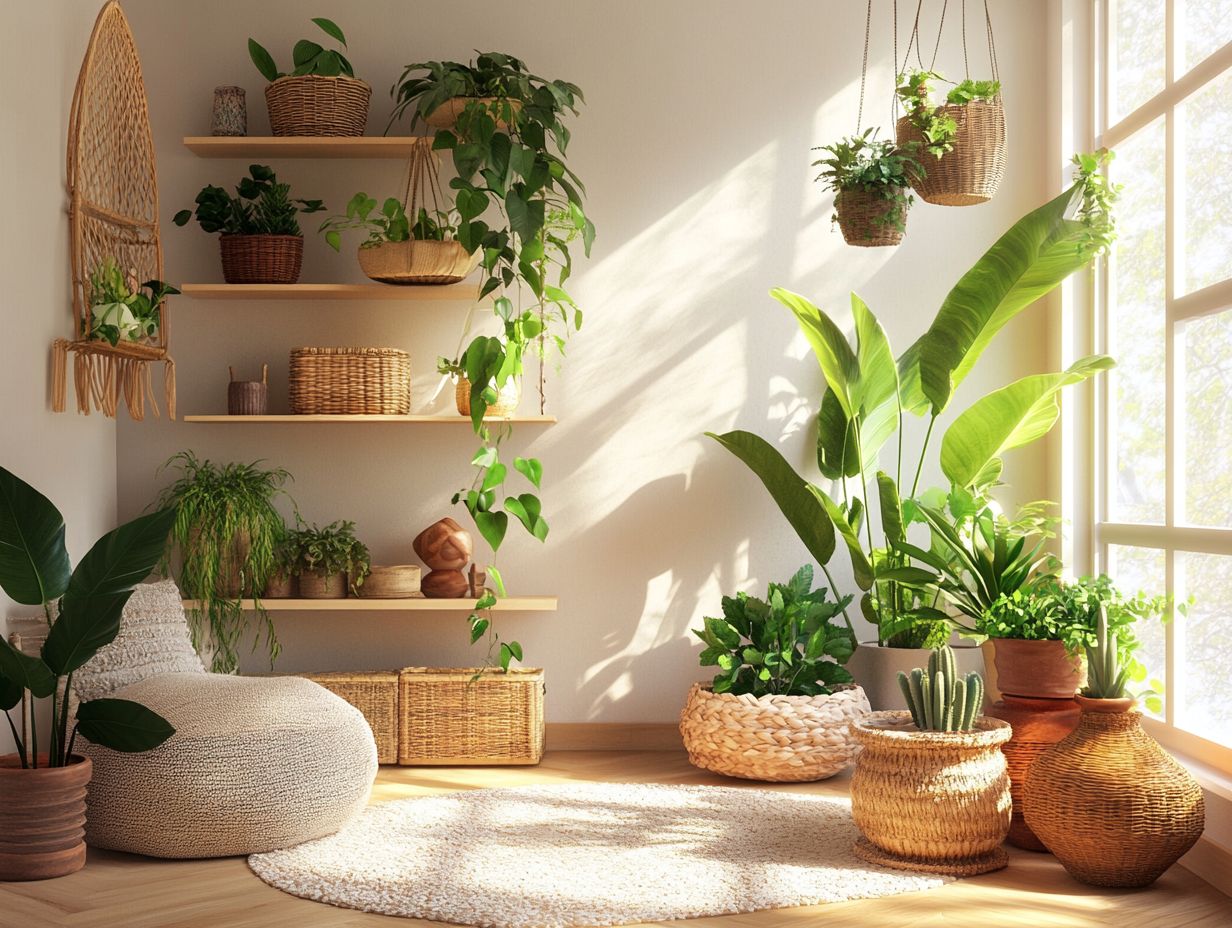
What is the art of layering plants in your decor?
The art of layering plants in your decor involves strategically arranging and combining different types of plants to create a visually appealing and dynamic display in your home.
Why should I incorporate layered plants in my decor?
Layered plants add depth, texture, and color to any room, bringing a natural and organic element into your living space. They also have the added benefit of purifying the air and promoting a sense of calm and relaxation.
What types of plants work best for layering?
Plants with varying heights, textures, and colors work best for layering. Mix and match tall trees or palms with medium-sized shrubs and low-growing ground cover or succulents for a visually interesting and balanced display.
How do I arrange layered plants in my decor?
Start by choosing a focal point or anchor plant, such as a large tree or statement piece. Then, add in layers of smaller plants around it, varying the heights and textures. You can also mix in hanging plants or vines for added dimension.
Do I need to have a green thumb to successfully layer plants in my decor?
No, you do not need to be an expert gardener to incorporate layered plants in your decor. Many low-maintenance and hardy plants are perfect for indoor use and require minimal care.
Are there any tips for maintaining layered plants in my decor?
Keep your plants thriving by watering and fertilizing them regularly! Pay attention to how much light and moisture each plant needs.
Prune and trim as needed to maintain their shape and prevent overcrowding. Watch out for pests and diseases to keep your plants healthy.

